Stability and Spin Waves of Skyrmion Tubes in Curved FeGe Nanowires
Abstract
1. Introduction
2. Micromagnetic Simulations
3. Results
3.1. Dynamic Susceptibility for Straight Nanowires ()
3.2. Dynamic Susceptibility for Curved Nanowires ()
4. Conclusions
Author Contributions
Funding
Data Availability Statement
Conflicts of Interest
Appendix A
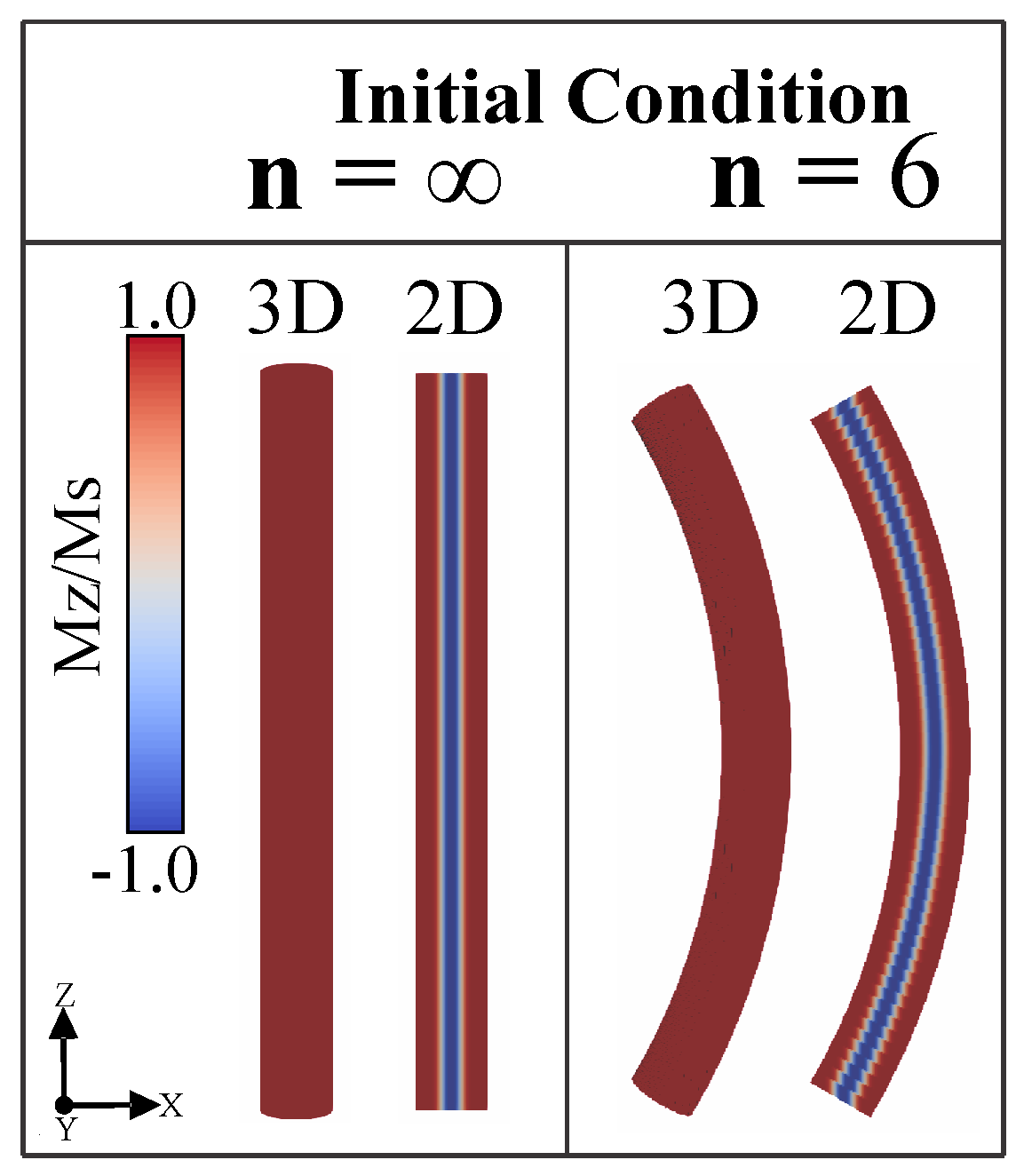
#####Part of code to define the geometry with n=6#####
angle:=angles*(pi/180)
angle_:=(90+angles)*(pi/180)
x := R_cur*sin(angle)
y := 0
z := R_cur*cos(angle)
Cilin_T := Cylinder(d_mon, h_mon).roty(angle_)
.transl(x,y,z).transl(-0.88*R_cur,0,0)
istep := 1
for i:=0; i<=angles; i+=istep{
theta:=i*(pi/180)
x := R_cur*sin(angle+theta)
y := 0
z := R_cur*cos(angle+theta)
Cilin := Cylinder(d_mon, h_mon).roty(angle_+theta).transl(x,y,z)
.transl(-0.88*R_cur,0,0)
Cilin_T=(Cilin_T.add(Cilin))
}
######Part of code to define the initial magnetization with n=6#####
for i:=0; i<=angles; i+=istep{
theta:= i*(pi/180)
x := R_cur*sin(angle+theta)
y := 0
z := R_cur*cos(angle+theta)
m.setinshape(Cylinder(d_mon, h_mon).roty(angle_+theta).transl(x,y,z)
.transl(-0.88*R_cur,0,0), BlochSkyrmion(1,-1)
.transl(x,y,z).transl(-0.88*R_cur,0,0))}
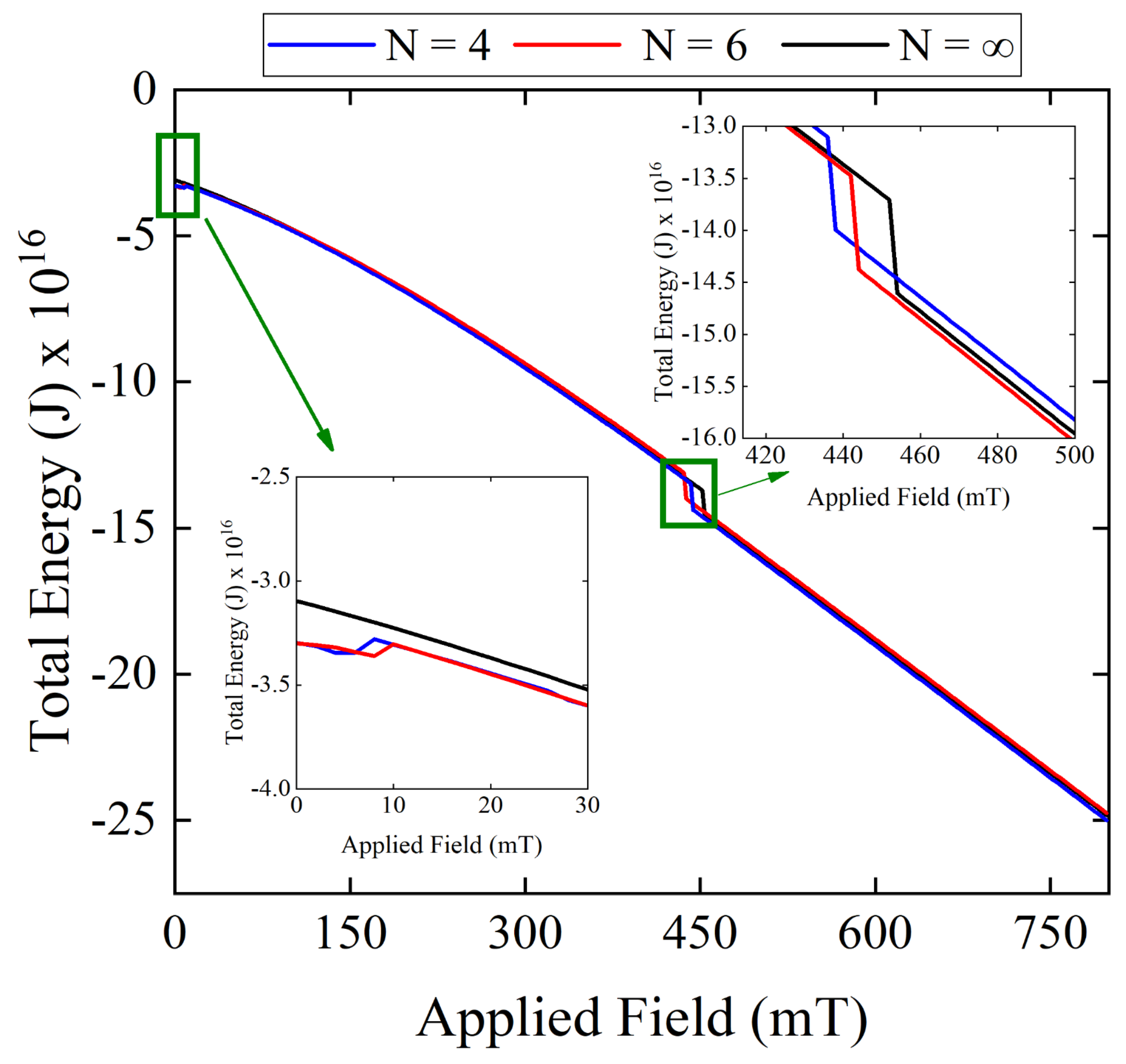
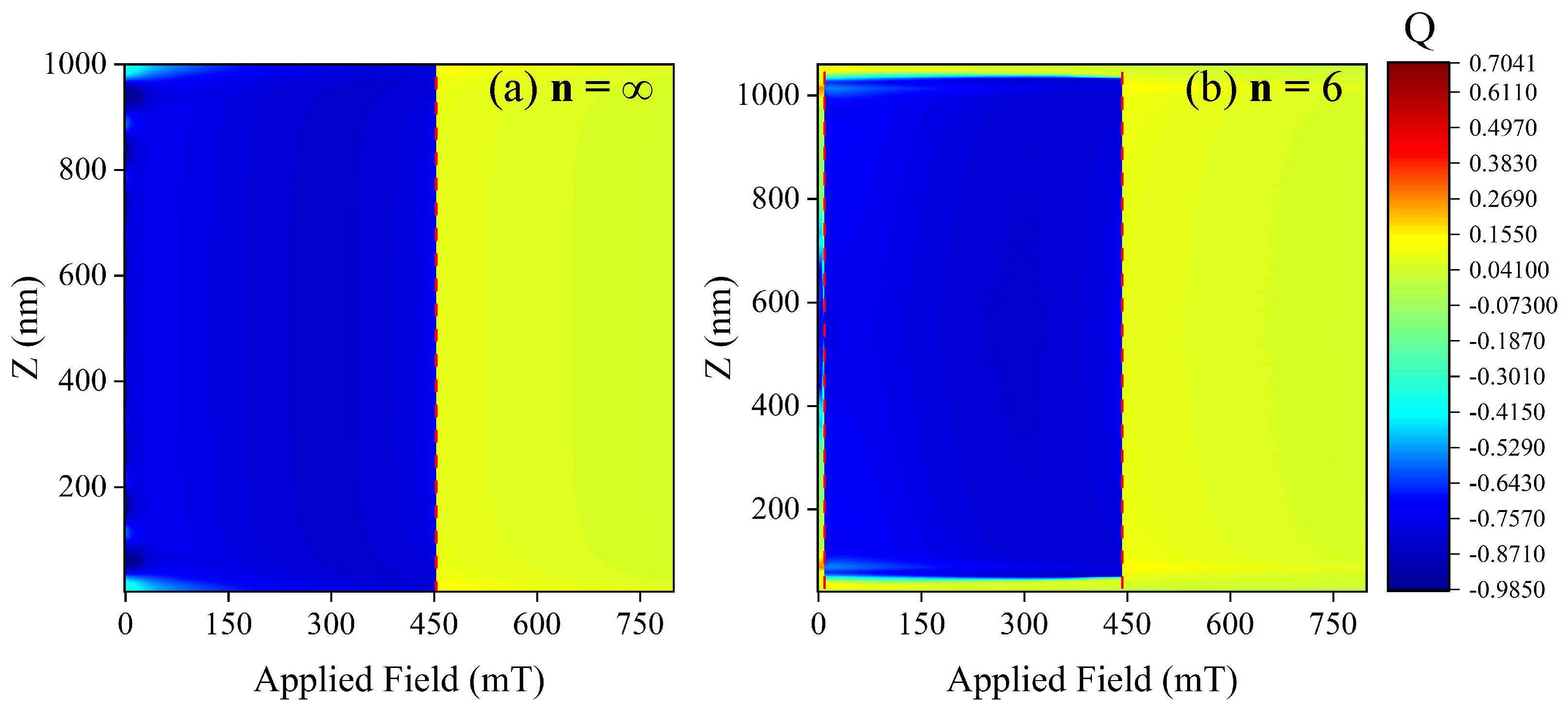

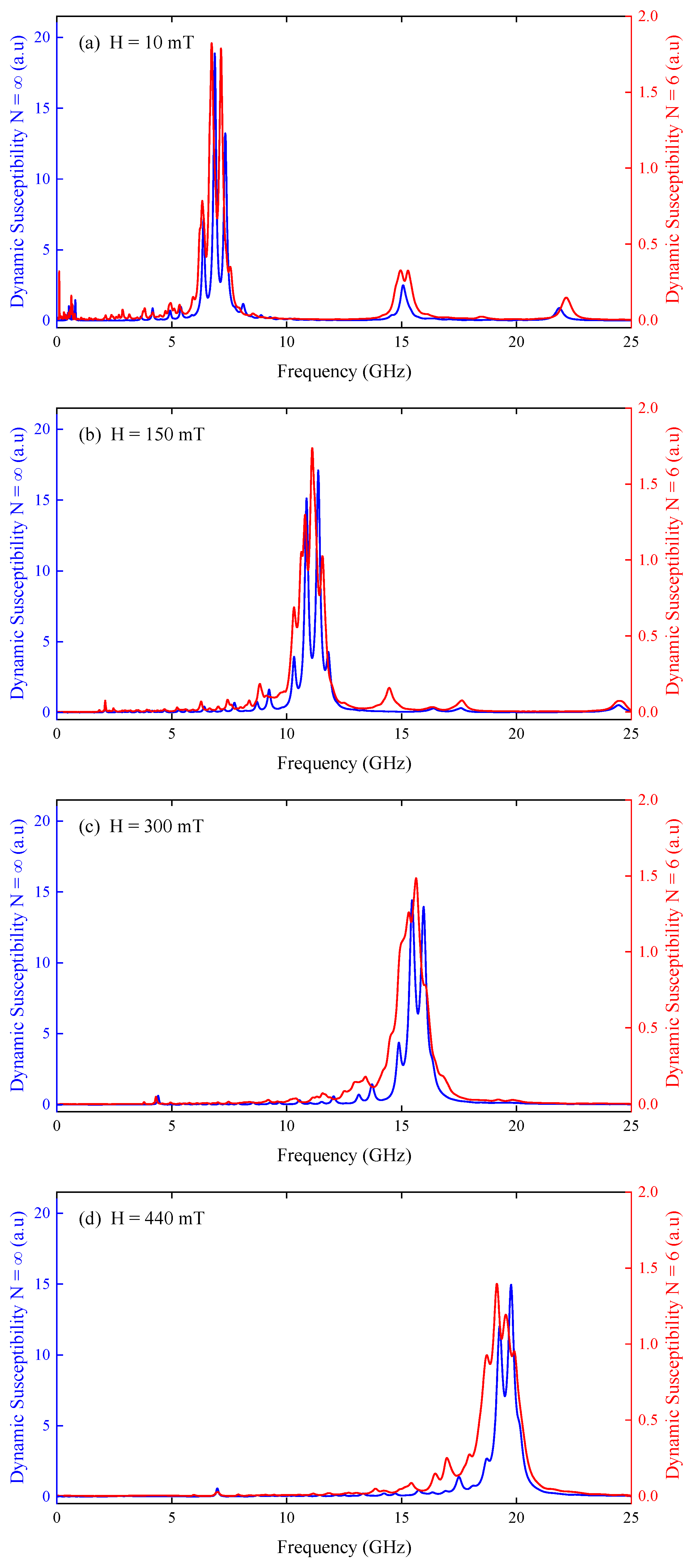
References
- Mukhtar, A.; Wu, K.; Cao, X.; Gu, L. Magnetic nanowires in biomedical applications. Nanotechnology 2020, 31, 433001. [Google Scholar] [CrossRef] [PubMed]
- Moreno, J.A.; Bran, C.; Vazquez, M.; Kosel, J. Cylindrical Magnetic Nanowires Applications. IEEE Trans. Magn. 2021, 57, 800317. [Google Scholar] [CrossRef]
- Sáez, G.; Cisternas, E.; Díaz, P.; Vogel, E.E.; Burr, J.P.; Saavedra, E.; Escrig, J. Tuning the coercive field by controlling the magnetization reversal process in permalloy modulated nanowires. J. Magn. Magn. Mater. 2020, 512, 167045. [Google Scholar] [CrossRef]
- Sáez, G.; Díaz, P.; Cisternas, E.; Vogel, E.E.; Escrig, J. Information storage in permalloy modulated magnetic nanowires. Sci. Rep. 2021, 11, 20811. [Google Scholar] [CrossRef] [PubMed]
- Sáez, G.; P Díaz, P.; Vidal-Silva, N.; Escrig, J.; Vogel, E. Bloch points stabilization by means of diameter modulations in cylindrical nanowires. Results Phys. 2022, 39, 105768. [Google Scholar] [CrossRef]
- Juge, R.; Bairagi, K.; Rana, K.G.; Vogel, J.; Sall, M.; Mailly, D.; Pham, V.T.; Zhang, Q.; Sisodia, N.; Foerster, M.; et al. Helium Ions Put Magnetic Skyrmions on the Track. Nano Lett. 2021, 21, 2989–2996. [Google Scholar] [CrossRef]
- Bran, C.; Fernandez-Roldan, J.A.; del Real, R.P.; Asenjo, A.; Chubykalo-Fesenko, O.; Vazquez, M. Magnetic Configurations in Modulated Cylindrical Nanowires. Nanomaterials 2021, 11, 600. [Google Scholar] [CrossRef]
- Bran, C.; Fernandez-Roldan, J.A.; Moreno, J.A.; Fraile Rodríguez, A.; del Real, R.P.; Asenjo, A.; Saugar, E.; Marqués-Marchán, J.; Mohammed, H.; Foerster, M.; et al. Domain wall propagation and pinning induced by current pulses in cylindrical modulated nanowires. Nanoscale 2023, 15, 8387–8394. [Google Scholar] [CrossRef]
- Dzyaloshinsky, I. A thermodynamic theory of “weak” ferromagnetism of antiferromagnetics. J. Phys. Chem. Solids 1958, 4, 241–255. [Google Scholar] [CrossRef]
- Moriya, T. Anisotropic superexchange interaction and weak ferromagnetism. Phys. Rev. 1960, 120, 91–98. [Google Scholar] [CrossRef]
- Nagaosa, N.; Tokura, Y. Topological properties and dynamics of magnetic skyrmions. Nat. Nanotechnol. 2013, 8, 899–911. [Google Scholar] [CrossRef]
- Fert, A.; Reyren, N.; Cros, V. Magnetic skyrmions: Advances in physics and potential applications. Nat. Rev. Mater. 2017, 2, 17031. [Google Scholar] [CrossRef]
- Tomasello, R.; Martinez, E.; Zivieri, R.; Torres, L.; Carpentieri, M.; Finocchio, G. A strategy for the design of skyrmion racetrack memories. Sci. Rep. 2014, 4, 6784. [Google Scholar] [CrossRef] [PubMed]
- Chen, X.; Chue, E.; Kong, J.F.; Tan, H.R.; Tan, H.K.; Soumyanarayanan, A. Thermal Evolution of Skyrmion Formation Mechanism in Chiral Multilayer Films. Phys. Rev. Appl. 2022, 17, 044039. [Google Scholar] [CrossRef]
- Khanh, N.D.; Nakajima, T.; Yu, X.; Gao, S.; Shibata, K.; Hirschberger, M.; Yamasaki, Y.; Sagayama, H.; Nakao, H.; Peng, L.; et al. Nanometric square skyrmion lattice in a centrosymmetric tetragonal magnet. Nat. Nanotechnol. 2020, 15, 444–449. [Google Scholar] [CrossRef] [PubMed]
- Hu, X.-C.; Wu, H.-T.; Wang, X.R. A theory of skyrmion crystal formation. Nanoscale 2022, 14, 7516–7529. [Google Scholar] [CrossRef]
- Back, C.; Cros, V.; Ebert, H.; Everschor-Sitte, K.; Fert, A.; Garst, M.; Ma, T.; Mankovsky, S.; Monchesky, T.L.; Mostovoy, M.; et al. The 2020 skyrmionics roadmap. J. Phys. D Appl. Phys. 2020, 53, 363001. [Google Scholar] [CrossRef]
- Bak, P.; Jensen, M.H. Theory of helical magnetic structures and phase transitions in MnSi and FeGe. J. Phys. C Solid State Phys. 1980, 13, L881–L885. [Google Scholar] [CrossRef]
- Yu, X.Z.; Kanazawa, N.; Onose, Y.; Kimoto, K.; Zhang, W.Z.; Ishiwata, S.; Matsui, Y.; Tokura, Y. Near room-temperature formation of a skyrmion crystal in thin-films of the helimagnet FeGe. Nat. Mater. 2011, 10, 106–109. [Google Scholar] [CrossRef]
- Huang, S.X.; Chien, C.L. Extended Skyrmion Phase in Epitaxial FeGe (111) Thin Films. Phys. Rev. Lett. 2012, 108, 267201. [Google Scholar] [CrossRef]
- Wilhelm, H.; Baenitz, M.; Schmidt, M.; Naylor, C.; Lortz, R.; Rößler, U.K.; Leonov, A.A.; Bogdanov, A.N. Confinement of chiral magnetic modulations in the precursor region of FeGe. J. Phys. Condens. Matter 2012, 24, 294204. [Google Scholar] [CrossRef] [PubMed]
- Turgut, E.; Matthew, J.S.; Jin, S.; Gregory, D.F. Topological spin dynamics in cubic FeGe near room temperature. J. Appl. Phys. 2017, 122, 183902. [Google Scholar] [CrossRef]
- Grytsiuk, S.; Hoffmann, M.; Hanke, J.-P.; Mavropoulos, P.; Mokrousov, Y.; Bihlmayer, G.; Blügel, S. Ab initio analysis of magnetic properties of the prototype B20 chiral magnet FeGe. Phys. Rev. B 2019, 100, 214406. [Google Scholar] [CrossRef]
- Zheng, F.; Li, H.; Wang, S.; Song, D.; Jin, C.; Wei, W.; Kovács, A.; Zang, J.; Tian, M.; Zhang, Y.; et al. Direct imaging of a zero-field target skyrmion and its polarity switch in a chiral magnetic nanodisk. Phys. Rev. Lett. 2017, 122, 197205. [Google Scholar] [CrossRef] [PubMed]
- Zheng, F.; Rybakov, F.N.; Kiselev, N.S.; Song, D.; Kovács, A.; Du, H.; Blügel, S.; Dunin-Borkowski, R.E. Magnetic skyrmion braids. Nat. Commun. 2021, 12, 5316. [Google Scholar] [CrossRef]
- Savchenko, A.S.; Zheng, F.; Kiselev, N.S.; Yang, L.; Rybakov, F.N.; Blügel, S.; Dunin-Borkowski, R.E. Diversity of states in a chiral magnet nanocylinder. APL Mater. 2022, 10, 061110. [Google Scholar] [CrossRef]
- Beg, M.; Carey, R.; Wang, W.; Cortés-Ortuño, D.; Vousden, M.; Bisotti, M.-A.; Albert, M.; Chernyshenko, D.; Hovorka, O.; Stamps, R.L.; et al. Ground state search, hysteretic behaviour and reversal mechanism of skyrmionic textures in confined helimagnetic nanostructures. Sci. Rep. 2015, 5, 17137. [Google Scholar] [CrossRef]
- Carey, R.; Beg, M.; Albert, M.; Bisotti, M.A.; Cortés-Ortuño, D.; Vousden, M.; Wang, W.; Hovorka, O.; Fangohr, H. Hysteresis of nanocylinders with dzyaloshinskii-moriya interaction. Appl. Phys. Lett. 2016, 109, 122401. [Google Scholar] [CrossRef]
- Booth, A.C.; Liu, Y.; Zang, J. Collective modes of three-dimensional magnetic structures: A study of target skyrmions. J. Magn. Magn. Mater. 2019, 489, 165447. [Google Scholar] [CrossRef]
- Bo, L.; Ji, L.; Hu, C.; Zhao, R.; Li, Y.; Zhang, J.; Zhang, X. Spin excitation spectrum of a magnetic hopfion. Appl. Phys. Lett. 2021, 119, 212408. [Google Scholar] [CrossRef]
- Saavedra, E.; Castillo-Sepúlveda, S.; Corona, R.M.; Altbir, D.; Escrig, J.; Carvalho-Santos, V.L. Influence of curvature on the dynamical susceptibility of bent nanotubes. Results Phys. 2022, 35, 105290. [Google Scholar] [CrossRef]
- Mancilla-Almonacid, D.; Castro, M.A.; Fonseca, J.M.; Altbir, D.; Allende, S.; Carvalho-Santos, V.L. Magnetic ground states for bent nanotubes. J. Magn. Magn. Mater. 2020, 507, 166754. [Google Scholar] [CrossRef]
- Hoang, Q.D.; Cao, H.X.; Nguyen, T.H.; Dao, A.V. Magnetic Domain Walls Moving in Curved Permalloy Nanowires under Continuous and Pulsed Fields. Commun. Phys. 2021, 31, 289. [Google Scholar] [CrossRef] [PubMed]
- Wild, J.; Meier, T.; Pöllath, S.; Kronseder, M.; Bauer, A.; Chacon, A.; Halder, M.; Schowalter, M.; Rosenauer, A.; Zweck, J.; et al. Entropy-limited topological protection of skyrmions. Sci. Adv. 2017, 3, e1701704. [Google Scholar] [CrossRef]
- Zhou, Y. Magnetic skyrmions: Intriguing physics and new spintronic device concepts. Natl. Sci. Rev. 2018, 6, 210–212. [Google Scholar] [CrossRef]
- Wigen, P.E. (Ed.) Nonlinear Phenomena and Chaos in Magnetic Materials; World Scientific: Singapore, 1994. [Google Scholar] [CrossRef]
- Gilbert, T.L. Classics in Magnetics A Phenomenological Theory of Damping in Ferromagnetic Materials. IEEE Trans. Magn. 2004, 40, 3443. [Google Scholar] [CrossRef]
- Guo, B.; Ding, S. Landau Lifshitz Equations; World Scientific: Singapore, 2008. [Google Scholar] [CrossRef]
- Clerc, M.G.; Coulibaly, S.; Laroze, D. Localized states beyond the asymptotic parametrically driven amplitude equation. Phys. Rev. E 2008, 77, 056209. [Google Scholar] [CrossRef]
- Mayergoyz, D.; Bertotti, G.; Serpico, C. Nonlinear Magnetization Dynamics in Nanosystems; Elsevier: Amsterdam, The Netherlands, 2009. [Google Scholar] [CrossRef]
- Lakshmanan, M. The fascinating world of the Landau–Lifshitz–Gilbert equation: An overview. Phil. Trans. R. Soc. A 2011, 369, 1280. [Google Scholar] [CrossRef]
- Vansteenkiste, A.; Leliaert, J.; Dvornik, M.; Helsen, M.; Garcia-Sanchez, F.; Waeyenberge, B.V. The design and verification of Mumax3. AIP Adv. 2014, 4, 107133. [Google Scholar] [CrossRef]
- Joos, J.J.; Bassirian, P.; Gypens, P.; Mulkers, J.; Litzius, K.; Van Waeyenberge, B.; Leliaert, J. Tutorial: Simulating modern magnetic material systems in mumax3. J. Appl. Phys. 2023, 134, 170901. [Google Scholar] [CrossRef]
- Vansteenkiste, A.A.; Van de Wiele, B. MuMax: A new high-performance micromagnetic simulation tool. J. Magn. Magn. Mater. 2011, 323, 2585–2591. [Google Scholar] [CrossRef]
- Fischbacher, T.; Franchin, M.; Bordignon, G.; Fangohr, H. A Systematic Approach to Multiphysics Extensions of Finite-Element-Based Micromagnetic Simulations: Nmag. IEEE Trans. Magn. 2007, 43, 2896–2898. [Google Scholar] [CrossRef]
- Scholz, W.; Fidler, J.; Schrefl, T.; Suess, D.; Dittrich, R.; Forster, H.; Tsiantos, V. Scalable parallel micromagnetic solvers for magnetic nanostructures. Comput. Mater. Sci. 2003, 28, 366–383. [Google Scholar] [CrossRef]
- Lopez-Diaz, L.; Aurelio, D.; Torres, L.; Martinez, E.; Hernandez-Lopez, M.A.; Gomez, J.; Alejos, O.; Carpentieri, M.; Finocchio, G.; Consolo, G. Micromagnetic simulations using Graphics Processing Units. J. Phys. D Appl. Phys. 2012, 45, 323001. [Google Scholar] [CrossRef]
- Leliaert, J.; Dvornik, M.; Mulkers, J.; De Clercq, J.; Milošević, M.V.; Van Waeyenberge, B. Fast micromagnetic simulations on GPU—recent advances made with mumax3. J. Phys. D Appl. Phys. 2018, 51, 123002. [Google Scholar] [CrossRef]
- Leliaert, J.; Mulkers, J. Tomorrow’s micromagnetic simulations. J. Appl. Phys. 2019, 125, 180901. [Google Scholar] [CrossRef]
- Kumar, D.; Adeyeye, A.O. Techniques in micromagnetic simulation and analysis. J. Phys. D Appl. Phys. 2017, 50, 343001. [Google Scholar] [CrossRef]
- Arora, N.; Das, P. Spin wave spectral probing of degenerate microstates in building-block of square artificial spin ice. AIP Adv. 2021, 11, 035337. [Google Scholar] [CrossRef]
- Pasquale, M.; Trabada, D.G.; Olivetti, E.S.; Sasso, C.P.; Coisson, M.; Magni, A.; Garcia-Sanchez, F.; Vazquez, M. Micromagnetic simulation of electrochemically deposited Co nanowire arrays for wideband microwave applications. J. Phys. D Appl. Phys. 2023, 56, 485001. [Google Scholar] [CrossRef]
- Corona, R.M.; Saavedra, E.; Castillo-Sepulveda, S.; Escrig, J.; Altbir, D.; Carvalho-Santos, V.L. Curvature-induced stabilization and field-driven dynamics of magnetic hopfions in toroidal nanorings. Nanotechnology 2023, 34, 165702. [Google Scholar] [CrossRef]
- Xing, X.; Zhou, Y.; Braun, H.B. Magnetic Skyrmion Tubes as Nonplanar Magnonic Waveguides. Phys. Rev. Appl. 2020, 13, 034051. [Google Scholar] [CrossRef]
- Charilaou, M.; Braun, H.-B.; Löffler, J.F. Monopole-Induced Emergent Electric Fields in Ferromagnetic Nanowires. Phys. Rev. Lett. 2018, 121, 097202. [Google Scholar] [CrossRef] [PubMed]
- Pereira, A.; Sáez, G.; Saavedra, E.; Escrig, J. Tunable Magnetic Properties of Interconnected Permalloy Nanowire Networks. Nanomaterials 2023, 13, 1971. [Google Scholar] [CrossRef] [PubMed]
- Fullerton, J.; Hierro-Rodriguez, A.; Donnelly, C.; Sanz-Hernández, D.; Skoric, L.; MacLaren, D.A.; Fernández-Pacheco, A. Controlled evolution of three-dimensional magnetic states in strongly coupled cylindrical nanowire pairs. Nanotechnology 2023, 34, 125301. [Google Scholar] [CrossRef]
- Lendinez, S.; Kaffash, M.T.; Heinonen, O.G.; Gliga, S.; Iacocca, E.; Jungfleisch, M.B. Nonlinear multi-magnon scattering in artificial spin ice. Nat. Commun. 2023, 14, 3419. [Google Scholar] [CrossRef]
- Saavedra, E.; Tejo, F.; Vidal-Silva, N.; Escrig, J. Magnonic key based on skyrmion clusters. Sci. Rep. 2021, 11, 23010. [Google Scholar] [CrossRef]
- Saavedra, E.; Tejo, F.; Vidal-Silva, N.; Escrig, J. Symmetry Breaking-Induced Resonance Dynamics in Bloch Point Nanospheres: Unveiling Magnetic Volume Effects and Geometric Parameters for Advanced Applications in Magnetic Sensing and Spintronics. ACS Appl. Mater. Interfaces 2024, 16, 27605–27613. [Google Scholar] [CrossRef]
- Chen, W.-B.; Han, M.-G.; Hao, Z.; Yu, O.; Deng, L.-J. Micromagnetic simulation on the dynamic susceptibility spectra of cobalt nanowires arrays: The effect of magnetostatic interaction. Chin. Phys. B 2010, 19, 087502. [Google Scholar] [CrossRef]
- Saavedra, E.; Vidal-Silva, N.; Escrig, J. Dynamic susceptibility of permalloy wire-tube nanostructures. Results Phys. 2021, 31, 104874. [Google Scholar] [CrossRef]
- Berganza, E.; Jaafar, M.; Fernandez-Roldan, J.A.; Goiriena-Goikoetxea, M.; Pablo-Navarro, J.; García-Arribas, A.; Guslienko, K.; Magén, C.; De Teresa, J.M.; Chubykalo-Fesenko, O.; et al. Half-hedgehog spin textures in sub-100 nm soft magnetic nanodots. Nanoscale 2020, 12, 18646–18653. [Google Scholar] [CrossRef]
- Dao, N.; Donahue, M.J.; Dumitru, I.; Spinu, L.; Whittenburg, S.L.; Lodder, J.C. Dynamic susceptibility of nanopillars. Nanotechnology 2004, 15, S634. [Google Scholar] [CrossRef]
- Saavedra, E.; Corona, R.M.; Vidal-Silva, N.; Palma, J.L.; Altbir, D.; Escrig, J. Dynamic and static properties of stadium-shaped antidot arrays. Sci. Rep. 2020, 10, 20024. [Google Scholar] [CrossRef] [PubMed]
- Bassirian, P.; Hesjedal, T.; Parkin, S.S.; Litzius, K. Breathing mode dynamics of coupled three-dimensional chiral bobbers. APL Mater. 2022, 10, 101107. [Google Scholar] [CrossRef]
- Sobucki, K.; Krawczyk, M.; Tartakivska, O.; Graczyk, P. Magnon spectrum of Bloch hopfion beyond ferromagnetic resonance. APL Mater. 2022, 10, 091103. [Google Scholar] [CrossRef]
- Ma, X.-P.; Cai, M.-X.; Li, P.; Shim, J.-H.; Piao, H.-G.; Kim, D.-H. Periodic vortex core switching in curved magnetic nanodisk. J. Magn. Magn. Mater. 2020, 502, 166481. [Google Scholar] [CrossRef]




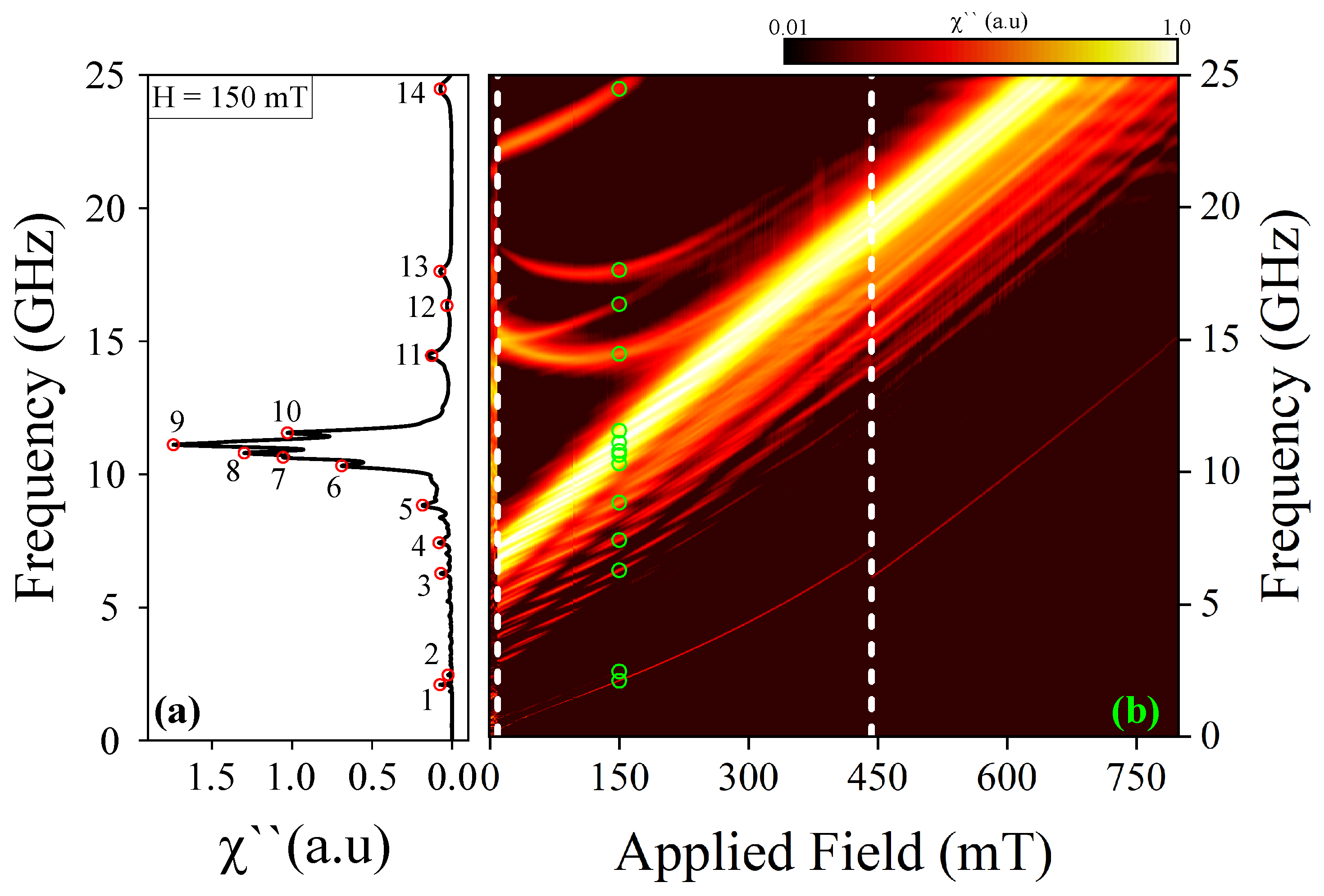
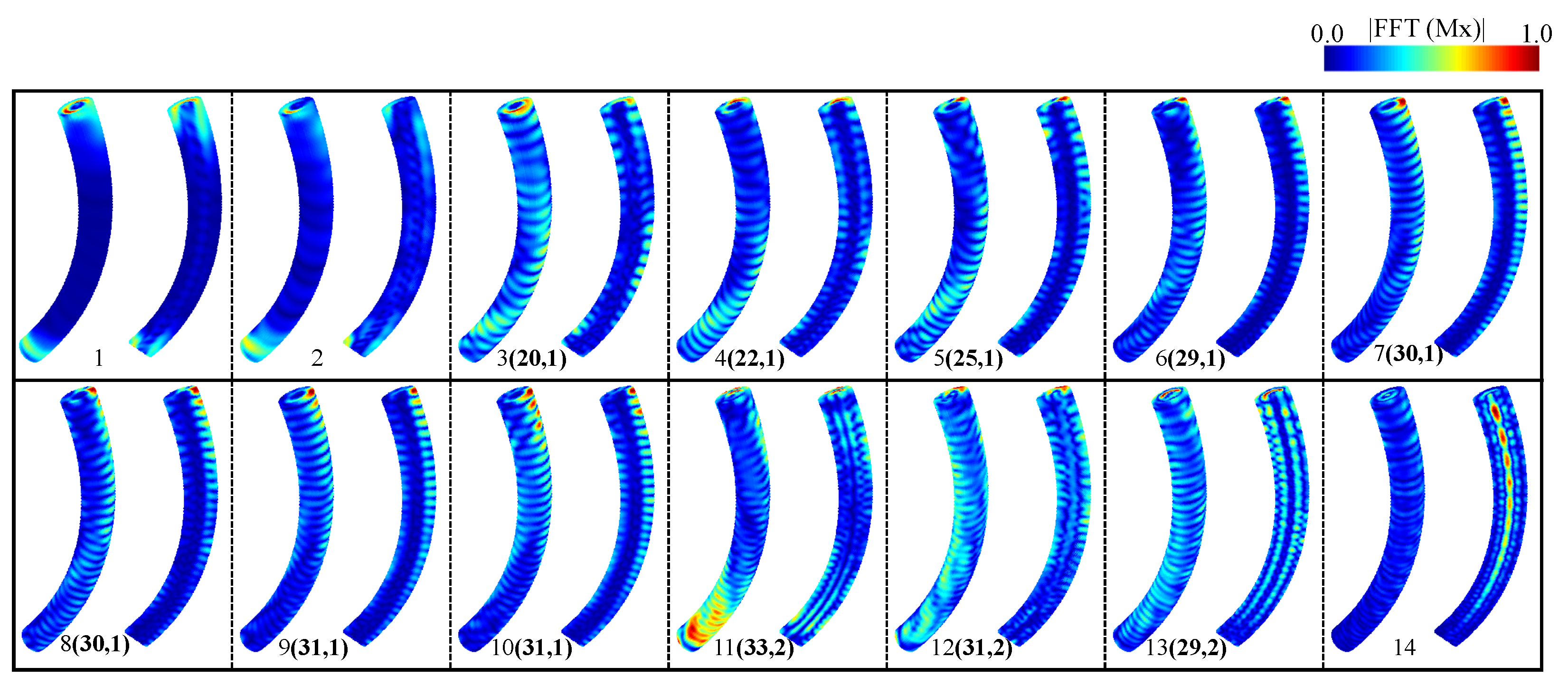
Disclaimer/Publisher’s Note: The statements, opinions and data contained in all publications are solely those of the individual author(s) and contributor(s) and not of MDPI and/or the editor(s). MDPI and/or the editor(s) disclaim responsibility for any injury to people or property resulting from any ideas, methods, instructions or products referred to in the content. |
© 2024 by the authors. Licensee MDPI, Basel, Switzerland. This article is an open access article distributed under the terms and conditions of the Creative Commons Attribution (CC BY) license (https://creativecommons.org/licenses/by/4.0/).
Share and Cite
Garrido-Tamayo, M.-A.; Saavedra, E.; Saji, C.; Guevara, U.; Pérez, L.M.; Pedraja-Rejas, L.; Díaz, P.; Laroze, D. Stability and Spin Waves of Skyrmion Tubes in Curved FeGe Nanowires. Nanomaterials 2024, 14, 1468. https://doi.org/10.3390/nano14181468
Garrido-Tamayo M-A, Saavedra E, Saji C, Guevara U, Pérez LM, Pedraja-Rejas L, Díaz P, Laroze D. Stability and Spin Waves of Skyrmion Tubes in Curved FeGe Nanowires. Nanomaterials. 2024; 14(18):1468. https://doi.org/10.3390/nano14181468
Chicago/Turabian StyleGarrido-Tamayo, Miguel-Angel, Eduardo Saavedra, Carlos Saji, Ulises Guevara, Laura M. Pérez, Liliana Pedraja-Rejas, Pablo Díaz, and David Laroze. 2024. "Stability and Spin Waves of Skyrmion Tubes in Curved FeGe Nanowires" Nanomaterials 14, no. 18: 1468. https://doi.org/10.3390/nano14181468
APA StyleGarrido-Tamayo, M.-A., Saavedra, E., Saji, C., Guevara, U., Pérez, L. M., Pedraja-Rejas, L., Díaz, P., & Laroze, D. (2024). Stability and Spin Waves of Skyrmion Tubes in Curved FeGe Nanowires. Nanomaterials, 14(18), 1468. https://doi.org/10.3390/nano14181468







